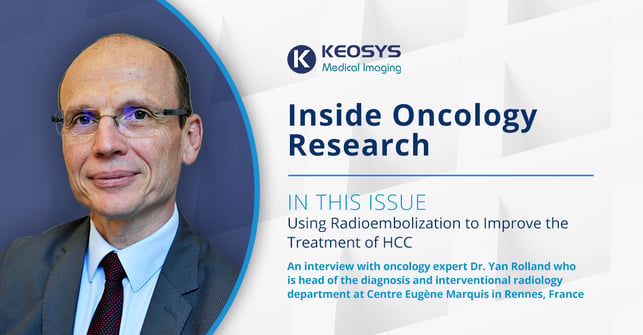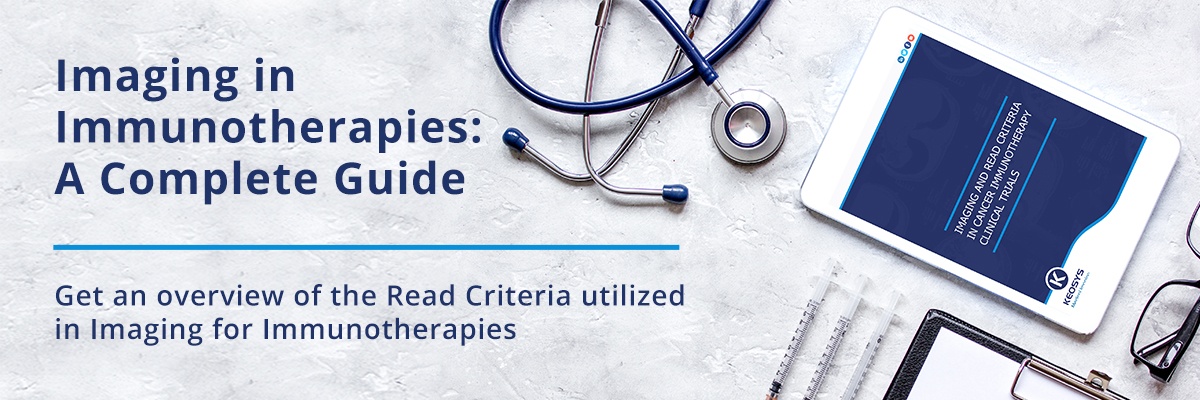Dr. Yan Rolland, head of the diagnosis and interventional radiology department at Centre Eugène Marquis, in Rennes, France, has been working to improve the treatment of hepatocellular carcinoma (HCC) for more than 30 years. We recently spoke with him about his career and the state of radioembolization today. The following is a selection of excerpts from our conversation.
Keosys: Your institution, Centre Eugène Marquis, has long been a world leader in the treatment of HCC with radioembolization.
YR: Yes. We had been treating a lot of HCC patients with chemoembolization, using an emulsion of Lipiodol® (a thick, oily contrast medium initially used for lymphography) and chemo followed by a gel foam embolization. In the ‘90s, in our center, we used Lipiodol to target liver tumors and radioactive iodine (131I) to treat thyroid cancers. We found a method to potentiate these two treating devices and developed the concept of internal radiation. Lipiodol is the vector of 131I, and the product was marketed as Lipiocis®.
Keosys: Were the treatments effective?
YR: Yes, we had excellent outcomes, especially in cases of tumors with portal vein invasion. But because iodine 131 is extremely radioactive, patients stayed in the hospital for a week in three dedicated rooms. This was a limitation of the technique in our center and only a few centers have such facilities to manage radioactivity. So, it was not easy for the technique to spread. Then, in 2007, we heard of radioactive glass beads with fewer radioactivity issues and started with this new platform to deliver local radiation therapy using an arterial route.
Keosys: It’s strange that the technique is called “radioembolization.”
YR: Yes. The word is terrible because “embolization” means you want to make occlusions, but that’s not what we do. We deliver radiation therapy. It’s “SIRT,” or “Selective Internal Radiation Therapy.” This means that I, as a radiologist, work with a nuclear physician to deliver the treatment. I am in charge of finding the best location for the catheter in the arterial tree. The nuclear physician takes care of calculating the dose of radioactive material.
Keosys: And what are the benefits of this treatment?
YR: Beyond a threshold, 100% of necrosis is obtained but it is necessary to target the tumor and avoid irradiation of the non-tumoral liver. That's why external radiation therapy is difficult to use in these pathologies. You cannot focus the beam enough to deliver treatment to the tumor without affecting an important volume of non-tumoral liver. Treatment through the vessels solved this problem because the lesions are hypervascularized, so this is the best way to deliver a high dose where you want it.
Keosys: When is the treatment indicated?
YR: Because this type of cancer is not painful, people often come in when the tumors are large and it's too late to get an option to be cured. We give these patients quality of life and improved life expectancy. Life expectancy had been six months, but with this treatment, it’s 24 months. Other clinical scenarios are downstaging of large tumors to be able to go to surgery or bridging to transplantation.
Keosys: Is a cure possible with this treatment?
YR: Only 25% of all patients are treated with curative intent when the tumors are small enough, mainly by surgery or by ablation. SIRT is sometimes performed with curative intent when surgery is not possible (radiation segmentectomy).
Keosys: How do you see the future of this technique? Will it change?
YR: For many years now, people have said, “Okay, when there’s nothing else to do, let's do SIRT. It’s just palliative.” But the configuration isn’t very good, so many patients who are very, very sick, don't improve. Sometimes you might even decrease their quality of life. This is a very effective technique, but patient selection and dose calculation have to be very accurate, otherwise it can be very toxic. Everyone needs to have this in mind.
Keosys: What are the challenges in using the technique?
YR: There are two parts to the technique: First, treatment simulation using a radioactive tracer to perform a liver scintigraphy and calculating the treatment dose you must order. If you can't achieve a good tumor dose, that’s a contraindication. In our point of view, you don't treat that patient. The second part, one week later, is microspheres injection. A lot of work has to be done by the radiologist to determine where to deliver the dose. This is extremely important because the way you navigate into the vessels can reduce the amount of treatment you're going to deliver. For example, you might expect 80-90% of the dose to get into the tumor and have 10% left outside the tumor. That’s reasonable. But if the radiologist managing the catheter in the vessels reduces the flow, or if he or she induces a spasm, less of the dose will get into the tumor. You may induce side effects without delivering the dose.
Keosys: It sounds like we need to be refining this technique and teaching people how to use it more effectively?
YR: Yes. With that in mind, we are developing software to help calculate what kind of dose should be delivered. Right now, it requires someone who is very experienced. If there were software telling them that they should be doing a dose of three gigabecquerel, but they calculate and find one, we can consider maybe the program is wrong, or maybe the calculation is wrong. But today, there is no check. Nobody tells you if it’s good or not good. In some centers, it's a problem because they are not experienced. So, the software could be used as a teaching tool or for quality control.
Keosys: Do you do a lot of teaching at your institution?
YR: Yes, but even with our trainees, it can be difficult. They do something, and I say, “Look. You did it wrong.” And they say, “No, I did everything right. I was very cautious.” But they are wrong. We start again and I do it myself and the results are very different. Then they say, “Ah.”
Keosys: You recently published some results in The Lancet, correct?
YR: Yes. A few years ago, phase III studies in Europe and Asia were negative because of poor inclusion criteria, no clear definition of the way to do the injections, and no dosimetry. As a result, people decided the technique doesn’t work. But we kept on with our work, and recently we published phase II study results. We showed that it does work, but you have to pay attention to what you're doing. It’s teamwork and it needs standardization.




